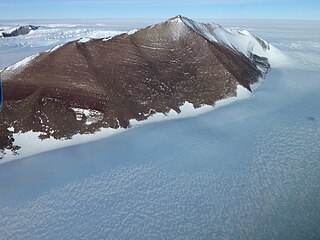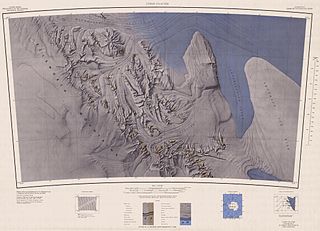Related Research Articles

The Pensacola Mountains are a large group of mountain ranges and peaks that extend 280 nautical miles in a northeast–southwest direction in the Transantarctic Mountains System, Queen Elizabeth Land region of Antarctica. They comprise the Argentina Range, Forrestal Range, Dufek Massif, Cordiner Peaks, Neptune Range, Patuxent Range, Rambo Nunataks and Pecora Escarpment. These mountain units lie astride the extensive Foundation Ice Stream and Support Force Glacier which drain northward to the Ronne Ice Shelf.
The McCuddin Mountains are a small cluster of mountains in Antarctica consisting mainly of two large mountains, Mount Flint and Mount Petras, along with several scattered peaks and nunataks. Located in Marie Byrd Land, 64 km (40 mi) east of the Ames Range, with Wallace Rock as its southeast extremity.

Bowers Corner is a peak located 9 nautical miles (17 km) southeast of Lishness Peak in Owen Ridge, the extreme south end of the main ridge of Sentinel Range in Ellsworth Mountains. The feature stands at the eastern side of the terminus of Nimitz Glacier where it bends, or makes a corner, on joining Minnesota Glacier. It was first mapped by the United States Geological Survey from surveys and from U.S. Navy air photos, 1957–59, and named by the Advisory Committee on Antarctic Names for Lieutenant Richard A. Bowers, U.S. Navy Reserve, who was in charge of the construction crew which built the IGY South Pole Station in the 1956–57 season.

Mount Bursik is the central peak, 2,500 metres (8,200 ft) high, of the Soholt Peaks, in the Heritage Range, Ellsworth Mountains. It was mapped by the United States Geological Survey from ground surveys and from U.S. Navy air photos, 1961–66, and named by the Advisory Committee on Antarctic Names for Captain Vlada D. Bursik, U.S. Navy, Deputy Commander, U.S. Navy Support Force, Antarctica, during Operation Deep Freeze 1966.
Chappell Peak is a peak, 1,860 metres (6,100 ft) high, standing 3 nautical miles (6 km) south of Schoeck Peak on the south side of the Enterprise Hills, overlooking the head of Horseshoe Valley in the Heritage Range. It was mapped by the United States Geological Survey from surveys and from U.S. Navy air photos, 1961–66, and named by the Advisory Committee on Antarctic Names for Richard L. Chappell, scientific aide at Little America V Station in 1957.
Courtney Peak is a peak, 1,060 metres (3,480 ft) high, in the northern part of the Gross Hills, Heritage Range. It was mapped by the United States Geological Survey from surveys and from U.S. Navy air photos, 1961–66, and named by the Advisory Committee on Antarctic Names for electronics technician Kenneth N. Courtney, U.S. Navy, who through Operation Deep Freeze 1966 contributed to efficient communications during six austral summer seasons.
Cunningham Peak is a mainly ice-covered peak, 2,170 metres (7,120 ft) high, at the head of Gowan Glacier along the Founders Escarpment, in the Heritage Range. It was mapped by the United States Geological Survey from surveys and from U.S. Navy air photos, 1961–66, and named by the Advisory Committee on Antarctic Names for Ship's Serviceman John B. Cunningham, U.S. Navy, in charge of the McMurdo Station ship's store and laundry during U.S. Navy Operation Deep Freeze 1966.

Grimes Glacier is a steep glacier descending from the east side of Anderson Massif, in the Heritage Range of the Ellsworth Mountains of Antarctica. It was mapped by the United States Geological Survey from surveys and U.S. Navy air photos, 1961–66, and was named by the Advisory Committee on Antarctic Names for Master Chief Equipmentman Paul D. Grimes, U.S. Navy, who supervised the construction crews during relocation of Williams Air Field at McMurdo Sound in the closing month of U.S. Navy Operation Deep Freeze 1965.

Gowan Glacier is a glacier about 15 nautical miles long in the Heritage Range of the Ellsworth Mountains of Antarctica, flowing north from the vicinity of Cunningham Peak in the Founders Escarpment to enter Minnesota Glacier just east of Welcome Nunatak. It was mapped by the United States Geological Survey from surveys and U.S. Navy air photos, 1961–66, and was named by the Advisory Committee on Antarctic Names for Lieutenant Jimmy L. Gowan, U.S. Navy Medical Corps, officer in charge and doctor at Plateau Station in 1966.
Eley Peak is a small rock peak (2311m) in the northern part of the Soholt Peaks, overlooking the head of Balish Glacier in the Heritage Range of the Ellsworth Mountains. It was mapped by the United States Geological Survey from surveys and U.S. Navy air photos, 1961–66, and was named by the Advisory Committee on Antarctic Names for Richard G. Eley, a U.S. Navy photographer on flights over Marie Byrd Land and Ellsworth Land, 1965–66 and 1966–67. It was first climbed on December 20, 2013, by Ralf Laier, Pachi Ibarra and Seth Timpano in Alpine style during their traverse of the Soholt Peaks.
Fendorf Glacier is a broad glacier draining from the eastern slopes of the Gifford Peaks and flowing north to merge with Dobbratz Glacier, in the Heritage Range of the Ellsworth Mountains, Antarctica. It was mapped by the United States Geological Survey from ground surveys and U.S. Navy air photos, 1961–66, and was named by the Advisory Committee on Antarctic Names for Lieutenant Commander James E. Fendorf, U.S. Navy, a pilot with Squadron VX-6 during Operation Deep Freeze 1966.
Huggler Peak is a sharp snow-covered peak, 1,580 metres (5,180 ft) high, in the northern part of Anderson Massif, in the Heritage Range of the Ellsworth Mountains, Antarctica. It was mapped by the United States Geological Survey from surveys and U.S. Navy air photos from 1961 to 1966, and was named by the Advisory Committee on Antarctic Names for John Q. Huggler, a U.S. Navy Reserve storekeeper who assisted in various construction projects at McMurdo Station during U.S. Navy Operation Deep Freeze in 1966.
Hessler Peak is a sharp peak, 1,670 metres (5,480 ft) high, at the south end of Dunbar Ridge in the Heritage Range in Antarctica. It was mapped by the United States Geological Survey from surveys and U.S. Navy air photos from 1961 to 1966, and was named by the Advisory Committee on Antarctic Names for Victor P. Hessler, an ionosphere physicist and United States Antarctic Research Program scientist at the Soviet Vostok Station in the 1965–66 and 1966–67 summer seasons.
Hurst Peak is a prominent rock peak, with an altitude of 1,790 metres (5,870 ft), at the southern end of the Webers Peaks in the Heritage Range of Antarctica. It was named by the University of Minnesota Geological Party, 1963–64, for aviation machinist James E. Hurst, who served as a crew member aboard the LC-47 aircraft that made the first 1963–64 flight to the Ellsworth Mountains.
Hutto Peak is a sharp peak, 1,620 metres (5,300 ft) high, standing just below the Founders Escarpment on the ridge separating the upper portions of Gowan Glacier and Splettstoesser Glacier, in the Heritage Range of mountains in Antarctica. It was mapped by the United States Geological Survey from surveys and U.S. Navy air photos from 1961 to 1966, and was named by the Advisory Committee on Antarctic Names for Chief Yoeman Grey H. Hutto of the U.S. Navy who was a participant in Operation Deep Freeze in two austral seasons in Antarctica in the period 1964–66.
Matney Peak is a mostly ice-free peak, 1,810 metres (5,940 ft) high, near the middle of the line of peaks on the east side of Webster Glacier in the Heritage Range of the Ellsworth Mountains, Antarctica. It was mapped by the United States Geological Survey from surveys and U.S. Navy air photos, 1961–1966, and was named by the Advisory Committee on Antarctic Names for Chief Aviation Boatswain's Mate William R. Matney of the U.S. Navy who contributed significantly to improving fuel operations in Antarctica and, for a portion of Operation Deep Freeze 1966, acted as fuels officer.
Mount Macalester is a prominent peak rising to 2,480 metres (8,140 ft) in the central part of the Soholt Peaks, Heritage Range, Ellsworth Mountains, Antarctica. It was mapped by the United States Geological Survey from surveys and U.S. Navy aerial photographs from 1961 to 1966. The peak was named by the Advisory Committee on Antarctic Names after Macalester College, the alma mater of Gerald F. Webers, the leader of the United States Antarctic Research Program Ellsworth Mountains Expedition of 1979–80. It was first climbed on December 28, 2013, by Ralf Laier, Pachi Ibarra and Seth Timpano in Alpine style during their traverse of the Soholt Peaks.
Mount Rodger is a sharp peak, 1,410 m, at the northwest end of Collier Hills in the Heritage Range in Antarctica. It was mapped by United States Geological Survey (USGS) from surveys and U.S. Navy air photos, 1961–66 and named by the Advisory Committee on Antarctic Names (US-ACAN) for Rodger A. Brown, meteorologist at Little America V Station in 1958.
The La Gorce Mountains are a group of mountains, 20 nautical miles long, standing between the tributary Robison Glacier and Klein Glacier at the east side of the upper reaches of the Scott Glacier, in the Queen Maud Mountains of Antarctica.
Rullman Peak is a peak, 1,910 m, located just south of Grimes Glacier in the Anderson Massif, Heritage Range. It was mapped by the United States Geological Survey (USGS) from surveys and U.S. Navy air photos from 1961 to 1966. It was named by the Advisory Committee on Antarctic Names (US-ACAN) for Chief Equipment Operator Gerald D. Rullman of the United States Navy, the direct supervisor of the crew that first pierced the Ross Ice Shelf at 160 ft during U.S. Navy Operation Deepfreeze in 1966. The drilling was accomplished near the Dailey Islands.
References
- ↑ "Lamb Peak". Geographic Names Information System . United States Geological Survey, United States Department of the Interior . Retrieved 24 May 2013.
![]() This article incorporates public domain material from "Lamb Peak". Geographic Names Information System . United States Geological Survey.
This article incorporates public domain material from "Lamb Peak". Geographic Names Information System . United States Geological Survey.
